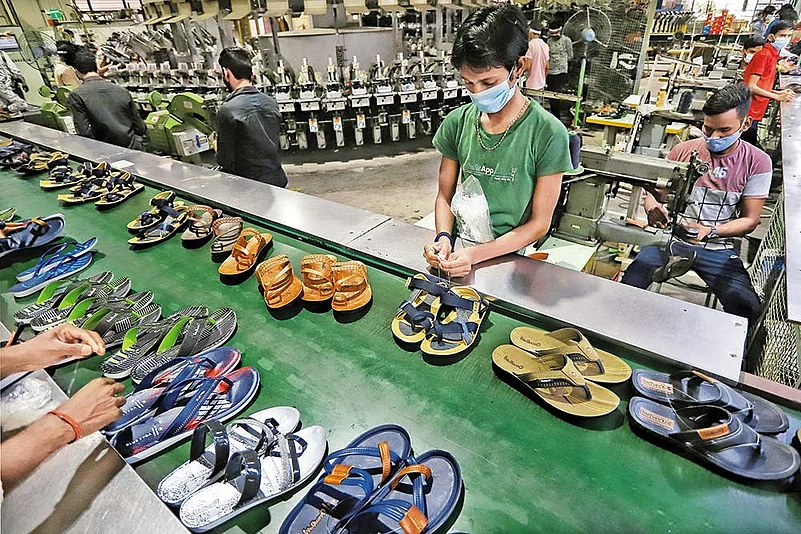There is significant uncertainty regarding an anticipated third wave of Covid-19, and businesses are still reluctant to hire. Moreover, the pandemic has impacted differently large companies, SMSEs (small- and medium-scale enterprises), and businesses in unorganised sectors. In the unorganised sector, a small enterprise such as a food stall or cycle repair shop earns every day and pays daily wages to employees. Maximum job losses happened in this segment.
After the Covid-induced disruptions and lockdowns, mid- and small-size enterprises managed to pull through for some time, but had to resort to wage cuts or layoffs ultimately. On the other hand, large, well-managed corporations like Mahindra, Tata, Birla, and others did not lay off staff. In fact, at Mahindra Group, we went out of our way to strengthen facilities for medical care for employees. Through our Family Assistance policy, family members are entitled to Rs 2 crore in the event of an individual’s unfortunate demise due to Covid.
A positive outcome of the events of the past one-and-a-half years is that companies have realised that there is headroom to boost business productivity and efficiency. Companies have been able to maintain production or output levels even with reduced headcount. As is evident from the results of many companies, profitability levels have increased. This is applicable across the spectrum, ranging from large companies such as Reliance, Jindal Steel, and Hindustan Lever to the smaller ones who have announced their annual and quarterly results recently.
Enablers of Growth
With the geopolitical situation changing, India is fast emerging as a potential manufacturing destination for multinational companies that view the country not only as a fast-growing consumer market, but also as a viable sourcing point for global markets. Sectors such as furniture, renewable energy equipment, garments, computers and mobile hardware are a few sectors that offer significant opportunities. We need to create appropriate infrastructure and skilling of workers in areas we want to grow. For instance, currently 80-90 per cent of the furniture made in India is done by carpenters using hand tools. If we want to become a global player in this segment, we have to train workers in mechanised methods. Around $20 billion worth of furniture is traded globally every year, and we account for a few million dollars.
The need of the hour is to focus on continually improving our Ease of Doing Business, and India must be perceived as an investor-friendly country. When it comes to training and skills development, we need to focus on indigenous areas of strength that will help us meet demand and gain a competitive edge as a global manufacturing hub. For example, when it comes to garment manufacturing, India is the preferred choice for designer wear for several leading global brands, while China scores on cheaper mass production of garments of daily use.

Unique Skill Development
Unfortunately, as a nation, we have failed to build on our demographic advantage. Over the past six decades, there has been little effort to upgrade curricula to keep pace with the changing, diverse global trends. For this, the industry is equally culpable. Companies failed to press for change to make courses more relevant to opportunities in the job market. A case in point is the apprenticeship programme, which has not been a success. The industry has to interact at three levels—curriculum, training trainers, and apprenticeship or internship opportunities for frontline workers across levels. Currently, most students seeking employment are not job-ready. We need to include vocational education as an optional or additional subject from the age of 13-14 years.
We must remove the stigma associated with blue-collared jobs. Unfortunately, unlike in most Western nations, no one aspires to work in a factory in India. People are not willing to work in a factory or a workshop, but do not hesitate to seek menial employment in five-star hotels. Efforts must be made to improve the attractiveness of working in factories or pursuing vocations like carpentry or masonry. Skills required by new-age industries are changing and we will accordingly need to upgrade and re-skill our workforce. As companies move up the value chain, they need to ensure that their products and services remain both relevant and sustainable.
Remote Working and Tech Prowess
Most of us did not imagine that remote working will work so well—as it has done through the course of the Covid-19 pandemic. Outsourcing, which has generated most of the jobs in India in the past 15 years, is expected to grow further and create new opportunities for Indian youth. The success of remote working and the gig economy has helped boost confidence among both job seekers and employers.

India’s technology success story started with Y2K, and companies that moved up the value chain post-2000 made it big. The current scenario presents another opportunity, with even higher-end outsourcing jobs expected to move to India. As the industry continues with its progression from call centers to managing processes, the clients will now seek opportunities higher up the pyramid.
Most new jobs are being created in technology, medical/pharmaceutical, retail, warehousing, and logistics sectors. Once the fear of the third wave recedes, we can expect the hospitality and construction segments to generate jobs. Domestic tourism will take off faster than international one. Another area where we can expect more jobs due to remote working is the pharmaceutical and healthcare business. I see a huge opportunity in the export of skilled health workers, given the significant global shortage of nurses and caregivers. I am optimistic about the job market but believe that we will go through some pain in the short run.
Skilling for Future
Re-skilling and preparing employees for jobs in the new growth sectors has to be the primary focus. In the long run, two categories of skills will be in demand. The first will be a set of skills required to effectively manage a diverse workforce—whether geographical, demographic, or social—as people continue to work remotely. It is unlikely that employers will ever return to a 100 per cent work-from-office scenario, as organisations are used to rotating staff. The new scenario will work to the advantage of working mothers as employers will be more compassionate to their needs and responsibilities. Having seen the success of hybrid work models over the past 15 months, many organisations may opt to partially continue with the same mode of work for another 2-3 years.
The second set of skills will be those related to new-generation ‘phygital’ (concept of using technology to bridge the gap between the digital world and physical world) concepts. With the world moving from the store to the doorstep, this will be yet another area where there will be a huge demand for right skills. While the first one will be a higher-end skill requirement, the second will be at the lower end.
As work from home continues to be relevant, organisations will have to focus on team building and collaborations, which is essential to workplace experiences and culture. In the absence of onsite work alongside colleagues, HR experts who ‘virtually’ build team spirit and keep up motivation levels will be in demand.
(This appeared in the print edition as "Headroom Ahead")
(As told to Lola Nayar)
Arun Nanda Former Chairman, CII National Committee on Skill Development & Livelihood, and Chairman, Mahindra Holidays & Resorts India
















